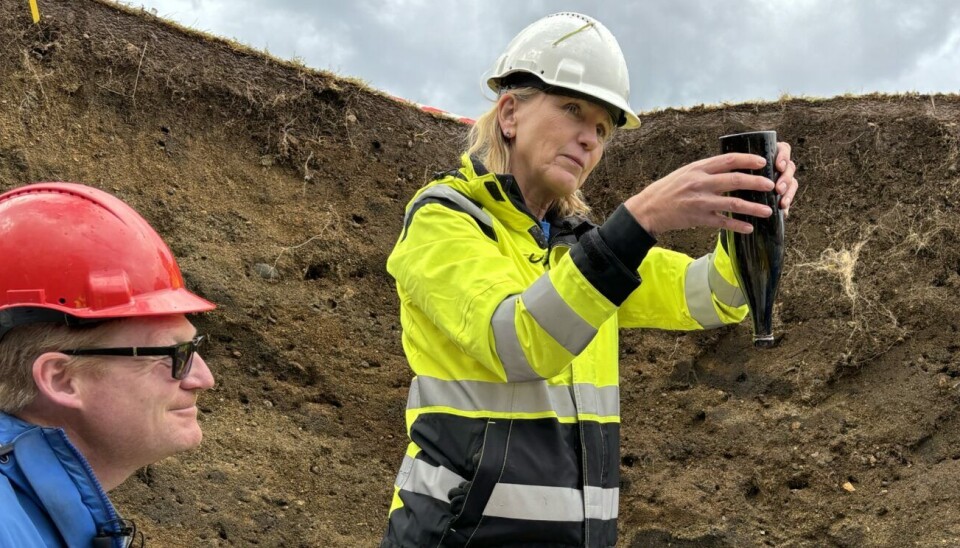
The Myklebust Ship: Unveiling Norway's Largest Viking Ship?
It has been 150 years since the first excavation of the Myklebust burial mound—a monumental site nestled in Nordfjordeid, Western Norway. The ongoing research seeks to unlock the secrets of what might be Norway's largest Viking ship burial. This latest excavation not only revisits the traces of a ship revealed in 1874 but also explores the possibility that this remarkable vessel, possibly the Myklebust Ship, could surpass known Viking ships in size, craftsmanship, and significance.
Rediscovering the Myklebust Ship
In 1874, archaeologist Anders Lorange uncovered a plethora of ship rivets within the Myklebust mound, hinting at a burial ship of grand proportions. However, he was only able to transport around 700 of the rivets back to Bergen, leaving behind another 600. A recent excavation by the University of Bergen’s team, led by Morten Ramstad, revealed these forgotten rivets, now in remarkably good condition. This discovery promises to shed new light on the Myklebust Ship's construction and possible dimensions.

More than 1,300 rivets have been uncovered in the Myklebust burial mound, revealing extensive ship burial remains. (Photo: Jan Magnus Weiberg-Aurdal / Norwegian Directorate for Cultural Heritage)
Ramstad notes the significance of these rivets: "These rivets will give us crucial information about the type of ship it was, its length, and what function it served." Based on early estimates, over 5,000 rivets may have once held this ship together, hinting at a size comparable to or larger than other renowned Viking ships. The team has also discovered shield bosses, essential elements in Viking armament that further point to the high status of the individual interred with this grand vessel.
What Makes the Myklebust Ship Unique?
While Viking ships such as the Gokstad and Oseberg are celebrated worldwide, the Myklebust Ship’s uniqueness lies in its cremation. Unlike other Viking burials, where ships were preserved, the Myklebust Ship was burned as part of the burial ritual—a distinctive practice in Western Norway where cremation was more common in Viking Age graves.

The Myklebust burial mound, located in the heart of Nordfjordeid in Western Norway. (Photo: Jan Magnus Weiberg-Aurdal / Norwegian Directorate for Cultural Heritage)
The cremation ritual raises fascinating questions about Viking beliefs and customs. Archaeologists are now collecting biological samples, hoping to reveal the season and setting of the burial. Were parts of the ship burned elsewhere and then brought to the mound, or was the entire vessel immolated on-site? These details will illuminate the burial rites practiced by Norse communities over 1,200 years ago, adding to our understanding of the spiritual significance of such rituals.
Reconstructing Norway’s Largest Viking Ship?
If the Myklebust Ship is indeed Norway’s largest Viking ship, it would challenge our current understanding of Viking naval architecture. Comparisons with existing ships underscore this potential:
- The Gokstad Ship, discovered in Norway, measures 23 meters with over 3,000 rivets.
- The Roskilde 6, the longest known Viking ship from Denmark, stretches between 36-37 meters.
Knut Paasche, a renowned archaeologist, notes that determining the Myklebust Ship’s true dimensions would require a full excavation of the mound, but even partial excavations already suggest a massive structure. However, questions remain about whether the unusually large rivets imply a larger vessel or simply a difference in materials. For instance, Christian Løchsen Rødsrud, who oversaw the Gjellestad Ship excavation, hypothesizes that the rivets’ size could indicate the use of pine instead of oak, requiring sturdier fastenings rather than a larger hull.
A Sacred Landscape: The Myklebust Burial Site
The Myklebust burial mound itself is a complex site that further emphasizes its importance. Lorange's early records mentioned a surrounding trench and two bridges, features confirmed in this latest excavation. The trench—measuring four meters wide and one meter deep—may have served a dual purpose: providing material for the mound’s construction and enhancing its visual impact as a spiritual threshold. The imagery of a Viking burial mound encircled by water evokes powerful associations with the Viking concept of the afterlife, depicting the mound as a “gateway to the realm of the dead.”
The Quest for UNESCO World Heritage Status
Beyond uncovering historical details, this excavation plays a role in Norway’s broader goal to secure UNESCO World Heritage status for its Viking Age heritage. The Norwegian Directorate for Cultural Heritage is working to include unaltered burial sites on the UNESCO list. Unlike the museum-bound Gokstad and Oseberg ships, sites like the Gjellestad and Myklebust mounds remain in their original locations, meeting a critical criterion for the UNESCO application.

Archaeologist Anders Lorange left a message in a bottle inside the burial mound, intended for future generations. University of Bergen’s rector, Margareth Hagen, will be the first to read it once conservators have carefully retrieved the fragile paper. (Photo: Jan Magnus Weiberg-Aurdal / Norwegian Directorate for Cultural Heritage)
Hanna Geiran, Director of the Norwegian Directorate for Cultural Heritage, emphasizes the importance of preserving such sites: "It’s very important to have physical traces for a World Heritage application. We now have those, which will strengthen the assessment we present to the Ministry of Climate and Environment for inclusion on Norway’s tentative list."
Conclusion
The Myklebust burial mound is an unparalleled archaeological site, promising answers to questions about Viking shipbuilding, burial rituals, and beliefs. Each rivet, shield boss, and trench provides clues, gradually piecing together the narrative of a possible Viking chieftain’s voyage into the afterlife. As archaeologists continue their work, the world eagerly awaits whether the Myklebust Ship will claim its place as Norway’s largest Viking vessel, adding a new chapter to our understanding of the Viking Age.
References
- Bergstrøm, I. I. (2024, October 25). Are the remains of Norway's largest Viking ship located here? Science Norway. Retrieved from https://www.sciencenorway.no/archaeology-cultural-heritage-culture/are-the-remains-of-norways-largest-viking-ship-located-here/2422530
- Weiberg-Aurdal, J. M. (Photographer). (2024). Ship rivets and shield bosses. [Photograph]. Norwegian Directorate for Cultural Heritage.
- Weiberg-Aurdal, J. M. (Photographer). (2024). The Myklebust mound. [Photograph]. Norwegian Directorate for Cultural Heritage.








